
If you're standing in the candy aisle with your kid begging for gummies, you might be wondering: can vegans eat Haribo? It's not a weird question. Loads of gummy candies, including those cheerful little bears, often hide animal-based ingredients. Even after years of reading labels for my daughter, Tamsin, Haribo packages still manage to surprise me.
Before you toss a bag into your basket, flip it over and look for sneaky words like 'gelatin'. That stuff comes from animal collagen (usually pig or cow), and it's what makes those candies so chewy. It's the ingredient that instantly makes most classic Haribo off-limits if you're vegan. There’s more to it, too—sometimes confectioner’s glaze or beeswax can slip in, which also aren't vegan-friendly.
- Why People Ask If Haribo Is Vegan
- What’s Actually in Haribo Gummies?
- How to Spot Animal Ingredients on Labels
- The Deal with Haribo’s Vegan Line
- Tasty Vegan Gummy Alternatives
- Check the Label: A Handy Tip for Candy Shopping
Why People Ask If Haribo Is Vegan
People always want to know if Haribo gummies are vegan because these chewy treats are everywhere—from party bowls to tuck shops. But if you follow a plant-based diet, knowing what’s inside really matters. The main reason for the question? Gelatin. It's a common ingredient in most gummy candies and it's made from animal bones, skin, and tendons. Once you start paying attention, you realize how many sweets use it.
This isn't just a few people fussing either. According to a 2024 consumer trends survey, 38% of shoppers said they looked for vegan or vegetarian labels on sweets at least once per month. That number has doubled since 2019. So, it’s not just a fad; folks actually want to know what’s in their food.
"Gelatin remains the key challenge in vegan confectionery. Many beloved sweets, including classic Haribo, contain it, but brands are working on plant-based updates for growing demand." — Plant Based Food Association Report, March 2024
People also get confused because Haribo sells different versions around the world. Sometimes the same gummy bears have slightly different recipes depending on the country. For example, Haribo sold in Germany sometimes uses beeswax for shine, while in the UK, they sometimes stick with gelatin, and in Turkey, you might find versions labeled as vegetarian.
If you’re checking candy labels, here’s what makes Haribo a hot topic:
- Kids ask for it all the time—it looks fun, and adults grew up with it.
- Many other mainstream candies are now labeled 'accidentally vegan,' so hopes are high.
- Some packaging doesn’t make it obvious—odd ingredient names make it tricky.
- Travelers spot different ingredients abroad and wonder which version is safe.
The simple truth? Unless the pack says vegan or vegetarian, most classic Haribo gummies are not vegan. But the demand is certainly making candy companies rethink their recipes.
| Country | Typical Haribo Ingredient | Vegan? |
|---|---|---|
| UK | Gelatin | No |
| Germany | Gelatin, Beeswax | No |
| Turkey | No Gelatin (Vegetarian line) | Sometimes |
| USA | Gelatin | No |
What’s Actually in Haribo Gummies?
When you break down the actual ingredients in most Haribo gummies, it’s not a happy story for vegans. The number one thing that pops up is gelatin. This is the stuff that gives gummies their bouncy texture, but it’s made from animal bones and skin. Yep, that's not plant-based.
It doesn’t stop at gelatin, though. Here’s a look at the usual suspects hiding inside most Haribo gummy packs:
- Gelatin: Made from animal sources (usually pork or beef).
- Sugar: Sometimes processed using bone char, depending on the country and manufacturer.
- Glucose Syrup: Typically plant-based, but always check the source.
- Confectioner’s Glaze (Shellac): Made from insects, used to give gummies their shine.
- Beeswax: Sometimes used as a coating so gummies don’t stick together.
- Artificial and Natural Flavors: These are normally vegan but are worth a double-check if you’re strict about it.
You might be surprised at how much these ingredients change depending on where the Haribo is made. For example, German Haribo and US Haribo sometimes list slightly different things. Here’s a quick comparison of Haribo Goldbears from the US and Germany:
| Country | Main Gelling Agent | Animal By-Products | Other Notes |
|---|---|---|---|
| USA | Gelatin (Pork) | Yes | Beeswax, Confectioner’s Glaze used |
| Germany | Gelatin (Pork) | Yes | Can contain carnauba wax instead |
| UK | Gelatin (Beef) | Yes | Some types use starch as a base (rare) |
The main takeaway? Those colorful bears almost always have animal ingredients in them, and recipes change depending on where you buy them. Even if you spot a bag labeled "vegetarian," it might still contain ingredients like beeswax. Double checking labels is the only way to be sure.
How to Spot Animal Ingredients on Labels
Most gummy candy, including Haribo, can be pretty sneaky about what goes in them. If you want to avoid animal stuff, the label is your best friend—but it helps to know what you’re actually looking for. A lot of the time, the culprit is gelatin. That's pretty much never vegan; it's made by boiling skin, bones, and connective tissues. If you see that word, put the bag back.
But it's not just gelatin. Here’s a list of some common animal-derived ingredients you might see hiding on candy packaging:
- Gelatin – from animal bones and tissues, usually pork or beef
- Beeswax/E901 – gives candy a shiny coating, made by bees
- Confectioner’s glaze/E904 (shellac) – from a bug called the lac insect
- Carmine/E120 – a red coloring made by crushing cochineal insects
- Lactose – milk sugar
- Honey – made by bees, pops up in some “natural” candies
Some of these sound harmless (shellac sounds like nail polish, right?) but they're absolutely not vegan.
Labels aren’t always crystal clear. Some companies just use “E” numbers, especially in Europe. Here’s a handy table with a few red flags to remember at the shop:
| Ingredient Name | Source | Vegan? |
|---|---|---|
| Gelatin | Animal (usually cow or pig skin/bones) | No |
| Beeswax (E901) | Bees | No |
| Confectioner’s Glaze (E904) | Lac insect | No |
| Carmine (E120) | Cochineal insects | No |
When in doubt, whip out your phone and Google the ingredient. If a candy says “vegetarian” on the pack, that's no guarantee it’s vegan; it might skip the gelatin but still have beeswax or dairy lurking inside. If you’re looking at Haribo or any other gummy, don’t just trust the picture of a smiling bear—those bears can be tricksters.

The Deal with Haribo’s Vegan Line
Here’s where things get interesting. Regular Haribo isn’t vegan, but Haribo started making plant-based options—just not everywhere. The company listened to years of requests and launched some vegan gummies that skip the gelatin. Instead, they use things like starch or agar-agar for the chewy texture, especially in parts of Europe like Germany and the UK. In the US, though, it’s still slim pickings for vegan options from them—and honestly, most American Haribo bags are just the classic, animal-based kind.
If you’re hunting for vegan Haribo, your best bet is to look outside the US for now. You’ll spot packs labeled “Vegan” on the front, usually in bright green. These lines swap animal-based stuff with plant-based options, making them actually fit the bill for vegans—and they’re way easier to find in stores like Sainsbury’s or Tesco (UK) or Rewe (Germany).
The actual flavors are somewhat different from the regular lineup. Here’s a quick look at some vegan-friendly Haribo lines you might see in Europe:
- Haribo Rainbow Strips Zourr (labeled “Vegan” in Europe)
- Haribo Soft Jelly Bears (vegan pack in the UK)
- Haribo Fruitilicious (uses pectin, no gelatin or beeswax)
Even with the “vegan” label, check the ingredients just to be sure, since recipes can change with different batches or countries. The key thing to look for in any Haribo pack is the absence of gelatin, beeswax, and anything called “carminic acid” or “E120” (that’s crushed bugs, believe it or not).
Here's a simple breakdown of common gelling agents and if they’re vegan:
| Gelling Agent | Vegan? | Usually Found In |
|---|---|---|
| Gelatin | No | Classic Haribo, most gummies in US |
| Pectin | Yes | Vegan Haribo, fruit jams |
| Agar-agar | Yes | Some Asian candies, vegan jellies |
| Starch | Yes | Some vegan gummies |
If you’re in Europe, you’ve actually got some decent vegan Haribo picks. For now, US vegans will have to wait or order online (and yes, those shipping fees aren’t fun). Just make sure you read every ingredient list, since it can change without warning.
Tasty Vegan Gummy Alternatives
Missing that chewy, fruity kick from Haribo isn’t fun, but honestly, there are so many solid vegan sweets out there now. Brands have caught onto the fact that vegans want legit gummy options, and you don’t have to hunt in weird specialty shops anymore. Grocery stores in the UK, the US, and even random corner shops often stock at least a couple of vegan gummy brands.
Here’s a quick table of some popular vegan gummy brands, what they’re known for, and where you might find them:
| Brand | What They Offer | Where to Buy |
|---|---|---|
| Sour Patch Kids (US/UK) | Classic sour gummies (US ones are usually vegan) | Walmart, Tesco, local shops |
| Vegummies | Fruit bears, worms, cola bottles (100% plant-based) | Online, TheVeganKind Supermarket |
| Jelly Tots | Tiny chewy fruit pieces, totally vegan | UK supermarkets |
| Starburst Gummies (US) | Some lines are vegan—always check packages | Target, big supermarkets |
| Candy Kittens | Trendy, chewy, fancy flavors (raspberry, peach, etc.) | Sainsbury’s, Boots, online |
If you want to try something homemade, it’s actually easier than you might think. All you need is fruit juice, a vegan gelling agent (like agar-agar or pectin), a bit of sugar, and a mold for fun shapes. Mix, heat it up, and let it set in the fridge. It’s a satisfying parent-kid project—I’ve made them with Tamsin, and she was stunned at how simple it was.
When you buy gummies, check the back of the pack for things like gelatin, beeswax, or carmine (that’s an insect-based dye) to keep it vegan. Some brands toss vegan labels right on the front, but not always. If you want a sure thing, products labeled “certified vegan” give you peace of mind.
One more tip: at Halloween or for parties, you can order giant bags of vegan gummy bears or worms online. This way, you’ve got enough to fill a candy bowl and not worry about your options running out.
Check the Label: A Handy Tip for Candy Shopping
If you want to figure out if your sweets are really vegan, don't trust the front of the package—always check the tiny print on the back. Even in the same brand, the recipe can be totally different depending on the flavor, the type, or even the country it’s made in.
The biggest thing to look for in gummy candies like Haribo is gelatin. It's usually listed right after glucose syrup or sugar near the top. But it's not the only animal ingredient sneaking into gummies. Candy makers love using these, so watch out for:
- Gelatin (not vegan, comes from animal bones and skin)
- Confectioner's glaze (also called shellac, made from bugs)
- Beeswax (used for shine, comes from bees)
- Carmine or E120 (a red coloring, also from bugs)
- Milk or milk derivatives like lactose or whey
Sometimes, even if it looks safe, you might spot confusing stuff like “natural flavors.” If you’re not sure, check if the bag says “suitable for vegans.” Some UK Haribo products do, but many don’t.
I always pull out my phone and Google the ingredients—or just skip the guessing and look for the vegan label. If it’s not clear, I tend to play it safe. Tamsin loves trying new treats, but she’s learned to point out the vegan symbol before I reach for my wallet.
Different countries have different Haribo formulas. For example, in Germany most Haribo gummies use animal gelatin. In the UK, you’ll occasionally spot a “vegan” range or ones made with starch instead. Here’s a handy table with the most common animal-derived ingredients hiding in candy:
| Ingredient | Source | Vegan? |
|---|---|---|
| Gelatin | Pig/Cow bones & skin | No |
| Confectioner's Glaze | Lac bug resin | No |
| Beeswax | Bees | No |
| Carmine/E120 | Crushed beetles | No |
| Starch | Plants (usually corn or potato) | Yes |
| Agar-Agar | Seaweed | Yes |
Bottom line: The ingredient list is your friend. No one wants to think they’re eating vegan only to find out they’ve accidentally downed a bug-based coloring. Take a minute to scan before you buy, and you’ll save yourself a lot of stress (and awkward questions from kids later). Candy shopping gets easier once you've done it a couple of times.








Write a comment